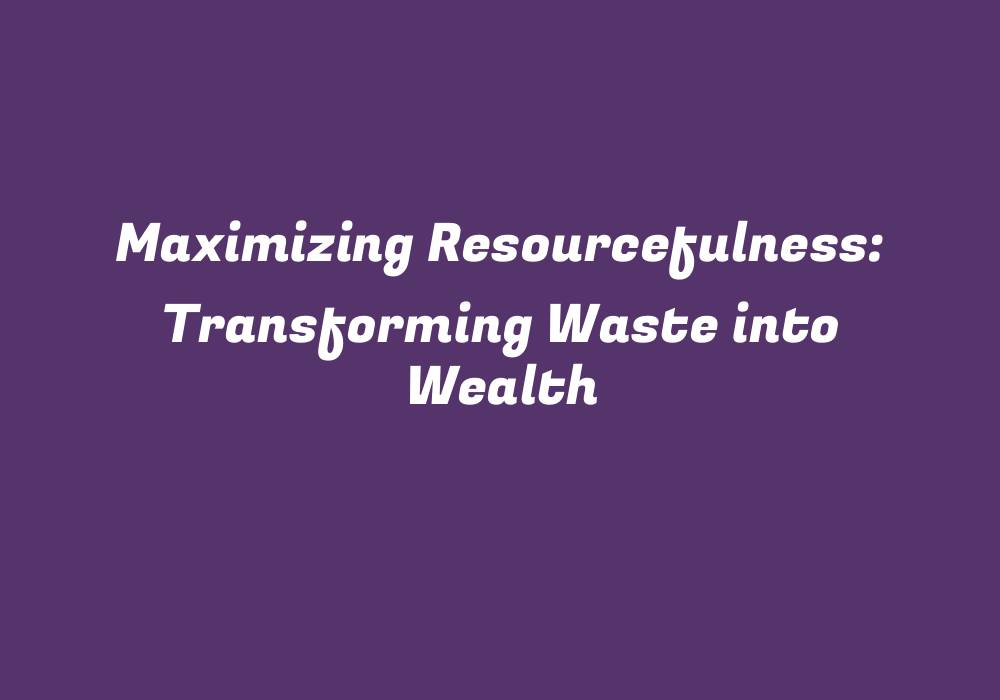Introduction
In today’s ever-changing world, resources are becoming increasingly scarce, and sustainability has become a top priority for businesses and individuals alike. Amidst these challenges lies the potential for turning waste materials into valuable commodities and creating wealth opportunities. Maximizing resourcefulness can not only lead to economic growth but also contribute positively to our environment. In this article, we will explore various strategies and real-life examples of transforming waste into wealth.
Repurposing Waste Materials
One effective approach to maximizing resourcefulness is repurposing waste materials. For example, turning plastic waste into building materials can reduce environmental pollution while also creating job opportunities. Companies like Eco-Cement in India and Novacem in the UK are researching ways to produce construction materials from plastic and other waste materials, respectively.
Recycling
Recycling is another powerful method of transforming waste into wealth. Recycled materials can replace virgin raw materials, thereby reducing the need for resource extraction while creating opportunities for value generation. For instance, in the United States alone, 75% of all aluminum ever produced is still in use today through recycling efforts.
Reverse Engineering
Reverse engineering involves disassembling a product or material to understand its composition and then replicating it. By analyzing the properties and design of existing materials, engineers can develop new, more sustainable alternatives that offer cost-saving benefits while minimizing environmental impact. For instance, in the fashion industry, companies like Adidas have created sneakers with upcycled plastic ocean waste as a replacement for virgin plastic.
Waste-to-Energy Technology
Converting waste materials into energy is another powerful way to maximize resourcefulness. Technologies like incineration, anaerobic digestion, and gasification can generate electricity or fuel from various types of waste materials such as municipal solid waste, biomass, and even human waste. In some countries, this method has already become a vital part of their energy portfolio.
Waste Management as a Business Opportunity
As businesses and individuals shift towards environmentally friendly practices, waste management becomes an increasingly valuable service. Developing innovative solutions for handling and processing waste materials can provide significant economic benefits. For instance, companies like Green Waste Recovery in Australia have become a leader in the recycling industry through their advanced technologies and commitment to sustainability.
Circular Economy Approach
A circular economy is an alternative to traditional linear models where resources are used efficiently, waste is minimized, and products can be reused or recycled at the end of their life cycle. Companies that adopt this approach often create a closed-loop system with minimal waste, which fosters innovation and resource conservation. For instance, Patagonia, an outdoor apparel company, has implemented a “Worn Wear” program where customers can return old clothes for repair or recycling.
Conclusion
Transforming waste into wealth is not only essential for a sustainable future but also offers numerous economic benefits. By exploring strategies like repurposing, recycling, reverse engineering, waste-to-energy technology, and embracing the circular economy approach, businesses and individuals can maximize resourcefulness while contributing to environmental conservation. As we continue to innovate new ways to address our waste problems, we can create a more prosperous and sustainable world for generations to come.
Examples of Waste Transformation into Wealth
- Plastics: Plastic waste is often seen as an environmental menace; however, many companies have found ways to transform it into valuable materials. For example, the French company Carbios has developed enzymatic solutions to recycle plastics into new raw material without degrading quality.
- Electronic Waste: The electronic waste problem has inspired numerous innovations in recycling and recovery processes. One such example is the Dutch company BlueCity, which converts electronic waste into valuable metals and plastics while generating energy from its process.
- Food Waste: Food waste can be used to create high-value products like compost, animal feed, and even biofuels. For instance, in Denmark, the company Danish Crown collaborates with local farmers to produce biofuel from food waste.
- Worn Clothing: Many companies are developing solutions for transforming worn-out clothing into new materials. For example, the Canadian company Bolt Threads uses yeast-based proteins to spin spider silk fibers that can be incorporated into fashion products made from recycled clothes.
